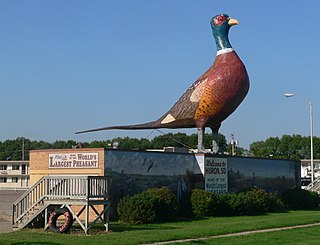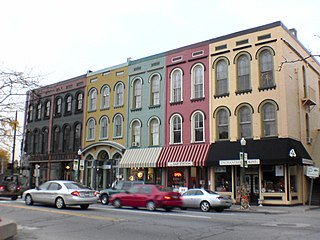
Huron is a city in Beadle County, South Dakota, United States. It is the county seat of Beadle County. The Huron Daily Plainsman, also referred to as the Plainsman, is the newspaper. The first settlement at Huron was made in 1880. The city was named after the Huron Indians. It is currently the eighth largest city in South Dakota, but it once was the fourth. In recent years, Huron's population has once again started to grow after nearly 20 years of stagnation. A welcoming immigration policy coupled with an economic revival in the area has sparked development. A Walmart Supercenter opened in the mid 2000s. Since Walmart's opening more commercial and residential development has occurred with the completion of a new Runnings store, and many new apartments, twin homes and houses.

The Dakota, Minnesota and Eastern Railroad is a Class II railroad and a subsidiary of the Canadian Pacific Railway, operating across South Dakota and southern Minnesota in the Northern Plains of the United States. Portions of the railroad also extend into Wyoming, Nebraska, Iowa, and Illinois.
The Fremont, Elkhorn and Missouri Valley Railroad (FE&MV), sometimes called "the Elkhorn," was a railroad established in 1869 in the state of Nebraska in the Midwestern United States.

The Chicago, Milwaukee, St. Paul and Pacific Railroad Depot and Lunchroom are two buildings located in Wells, Minnesota, and built by the Chicago, Milwaukee, St. Paul and Pacific Railroad in 1903.

The Minnesota 400 was a streamlined passenger train operated by the Chicago and North Western Railway on its southern Minnesota line between Mankato, Minnesota and Wyeville, Wisconsin. It began running in 1936. In 1950 it was extended to run between Chicago, Illinois and Huron, South Dakota and renamed the Dakota 400. It would be further extended to Rapid City, South Dakota, before being cut back to Mankato, in 1960. This final iteration was named the Rochester 400 and it ceased operation in 1963.

The Burlington, Cedar Rapids and Northern Railway (BCR&N) was a railroad that operated in the United States from 1876 to 1903. It was formed to take over the operations of the bankrupt Burlington, Cedar Rapids and Minnesota Railway, which was, in turn, the result of merging several predecessor lines, the construction of which began in 1869. The corporate headquarters were in Cedar Rapids, Iowa, and it had operations in Iowa and in Minnesota. It was succeeded by the Chicago, Rock Island and Pacific Railway.

The Two Brothers Roundhouse, formerly the Walter Payton Roundhouse, America's Historical Roundhouse, and Chicago, Burlington, & Quincy Roundhouse and Locomotive Shop is a historic building converted to a restaurant in Aurora, Illinois. It was originally constructed in 1856 as a roundhouse for the Chicago & Aurora Railroad and served in this capacity until 1974. It was abandoned until 1995, when a group of investors led by Walter Payton purchased it and converted the building to an entertainment complex. Its most recent tenant is Two Brothers Brewing. The building is the oldest limestone roundhouse in the United States and is listed on the National Register of Historic Places.

Union Station, also known as Union Station and Burlington Freight House, is located near the riverfront in downtown Davenport, Iowa, United States. It is listed on the National Register of Historic Places. The buildings are in a section of downtown with several historic structures. Across Ripley Street to the west is the Chicago, Milwaukee, St. Paul and Pacific Freight House, and to the east across Harrison Street is the Dillon Memorial. On River Drive northwest from the Burlington Freight House is The Linograph Company Building. Across Beiderbecke Drive to the south are the W.D. Petersen Memorial Music Pavilion and the Mississippi River.
Frost & Granger was an architectural partnership from 1898 to 1910 of brothers-in-law Charles Sumner Frost (1856–1931) and Alfred Hoyt Granger (1867–1939). Frost and Granger were known for their designs of train stations and terminals, including the now-demolished Chicago and North Western Terminal, in Chicago. The firm designed several residences in Hyde Park, Illinois, and many other buildings. Several of their buildings are listed on the U.S. National Register of Historic Places.

City Hotel, also known as Seifert's Tavern and the Wheatland Feed Mill, on 214 South Main Street in Wheatland, Iowa was listed on the National Register of Historic Places for Clinton County, Iowa in 2007.
The Chicago and North Western Passenger Depot is a historic building located in Wall Lake, Iowa, United States. Wall Lake was served by both the Chicago & North Western Railroad and the Illinois Central Railroad, which gave it a significant rail presence from the 1880s until World War II. The C&NW depot is an example of a combination station plan. The plan combined both passenger and freight services in one building. They were commonly used during the heyday of railroad growth round the turn of the 20th century. However, the old Wall Lake C&NW depot was moved and used for freight. What would have been the freight room was used here for a lunchroom. C&NW had three standard combination depot plans that have been attributed to the prominent Chicago architectural firm of Frost & Granger. The Wall Lake depot was the largest of the three as it incorporated a women's waiting room, but it was actually 9 feet (2.7 m) shorter than the general plan because freight was processed in another facility. The depot was built in 1899 by A.H. Carter & Co. of Cedar Rapids, Iowa as a replacement depot. The single-story frame structure is the only building used as a depot that remains in town. It was listed on the National Register of Historic Places in 2003.

The Ypsilanti Historic District is a historic district located along several blocks on each side of the Huron River in the center of Ypsilanti, Michigan. The original portion of the district was designated a Michigan State Historic Site in 1973 and listed on the National Register of Historic Places in 1978; additions to the district were nationally listed in 1989.
The Winona and St. Peter Railroad was a railroad in the Midwestern United States. It was founded in 1861 in Winona, Minnesota. The first 11 miles (18 km) from Winona to Stockton, Minnesota, were completed by the end of 1862, making the it the second operational railroad in Minnesota, after the St. Paul and Pacific Line from Saint Paul to St. Anthony Falls.

The Burlington, Cedar Rapids, and Northern Railroad-Rock Rapids Station, Railroad Track and Bridge is a nationally recognized historic district located in Rock Rapids, Iowa, United States. It was listed on the National Register of Historic Places in 1976. At the time of its nomination the district included one contributing building and three contributing structures.

The Belle Plaine Main Street Historic District is a nationally recognized historic district located in Belle Plaine, Iowa, United States. It was listed on the National Register of Historic Places in 2013. At the time of its nomination it contained 63 resources, which included 46 contributing buildings, one contributing structure, and 16 non-contributing buildings. The historic district covers most of the city's central business district. Belle Plaine was laid out in 1862 as a railroad town. The Chicago & North Western Railroad was extended from Cedar Rapids the following year. The commercial district is adjacent to the tracks. A major fire destroyed much of the business district in 1894. Thirty-five buildings in the district were built in the months after the fire.
Outlook station is a railway depot in Outlook in Sheridan County, Montana which was listed on the National Register of Historic Places in 1993 as the Outlook Depot. It has also been known as Soo Line Depot. The listing included two contributing buildings.

The Chicago and North Western Depot in Waukesha, Wisconsin is a railroad depot built in 1881 and operated by the Chicago and North Western Railway. It is a 1.5-story cream brick building and was originally built for a predecessor of the C&NW. It now operates as a Mexican restaurant, La Estacion. Behind the building are five passenger cars, believed to have belonged to the Gulf, Mobile and Ohio Railroad. These serve as extra dining space. Two boxcars and a caboose sit in the front of the depot, however their origins remain unknown. The depot is located next to a Wisconsin and Southern Railroad mainline, with a junction connecting it and the Canadian National Railway's Waukesha Subdivision just to the east. The C&NW track west of WI 164 has since been removed.

Marion station was a railroad station in Marion, Iowa. It served passenger trains of the Chicago, Milwaukee, St. Paul and Pacific Railroad, commonly known as the Milwaukee Road. After passenger train service was discontinued, elements of the station were moved across the street to City Square Park, where it remains as a pavilion today. The structure is listed as a non-contributing property by the National Register of Historic Places in the Marion Commercial Historic District.

Madison station is a former railroad station in Madison, Wisconsin. The station served passenger and freight trains of the Chicago and North Western Railway (C&NW). Passenger service ended in 1965 and the passenger station and freight depot was bought by Madison Gas and Electric (MGE) and has been renovated to serve as offices. The station and freight depot are listed as contributing properties on the National Register of Historic Places East Wilson Street Historic District. The Chicago, Milwaukee, St. Paul and Pacific Railroad had tracks paralleling the C&NW and also had a nearby passenger station that outlasted the C&NW station by several years.

















